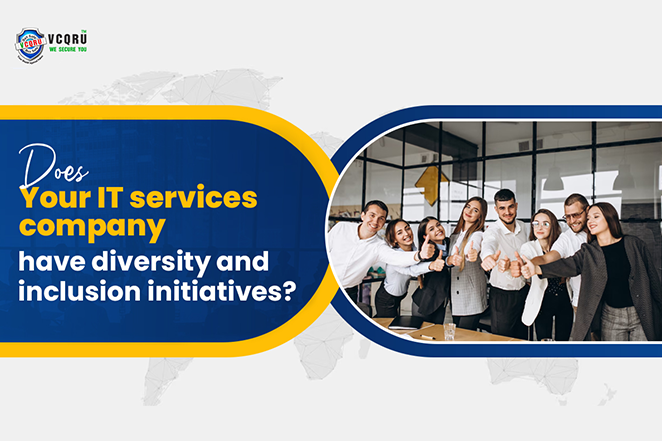

It is very difficult to represent a specific company, but many IT services companies have various initiatives to foster diversity and inclusivity. I can provide you with a list of common diversity and inclusivity initiatives that many companies in the IT industry adopt. Keep in mind that the actual initiatives may vary based on the company's size, location and industry. Here are some common initiatives:
Conducting workshops and training programs to raise awareness about diversity and inclusion issues. Diversity training, also known as integration training or cultural competence training, is a process designed to educate employees about the importance of diversity and inclusion in the workplace. The purpose of diversity training are to increase awareness, transparency, reduce prejudice and stereotypes and promote an inclusive work environment.
Establishing ERGs to provide a supportive community for employees who share common characteristics, such as gender, ethnicity, or sexual orientation. Employee Resource Groups (ERGs) also known as affinity groups or employee networks, are voluntary, employee-led organizations within a company that include individuals with similar interests, backgrounds, or characteristics. The primary purpose of ERGs is to create a supportive and inclusive workplace by fostering a sense of community, promoting diversity, and addressing the unique needs and concerns of specific groups.
Implementing diverse hiring practices to ensure a fair representation of different backgrounds in the recruitment process. Diverse recruitment practices are strategies and tasks that organizations use to attract, recruit, and retain diverse employees. The goal is to ensure that the recruitment process is inclusive and provides equal opportunities for individuals from various backgrounds.
Offer mentoring programs to help underrepresented employees advance in their careers. Sponsorship programs recommend employees at the highest levels of the organization. Counseling and support programs are services designed to support the professional development and growth of employees within an organization.
Introducing a flexible work schedule to meet needs and promote work life balance. Flexible work policies refers to organizational practices that give employees greater control over when, where, and how they work. These policies aim to provide a work environment that accommodates diverse needs and aspirations, promotes work-life balance and supports employee well-being.
Providing leadership training to promote inclusive leadership behaviors and practices. Inclusive leadership training is designed to equip leaders and managers with the knowledge, skills, and attitudes necessary to create and maintain an inclusive workplace environment. Inclusive leadership fosters a culture that values, embraces difference , and ensures that every person is welcomed, valued and empowered to express their best emotions.
Conducting regularly analyzes various features and integration processes to measure effectiveness and identify areas for improvement. Regular diversity and inclusion assessments are important tools for organizations to evaluate the effectiveness of their diversity and inclusion (D&I) programs, identify areas for improvement, and ensure continuous improvement. These assessments involve systematic reviews of organizational policies, practices and cultures related to diversity and inclusion.
Ensuring that there are no gender or ethnicity-based pay gaps through regular audits. An equal pay audit is a comprehensive audit conducted by organizations to monitor and ensure that there is no gender or other discrimination in pay structures. The primary objective of equal pay auditing is to identify and resolve any pay gap between employees performing the same job or occupation of equal value, regardless of gender or other protected characteristics.
Actively working towards having a diverse representation in leadership positions. Encouraging diversity in leadership includes intentional efforts to increase representation from various backgrounds and underrepresented groups in leadership positions within an organization. Diverse leadership not only fosters a more inclusive and equitable workplace but also contributes to better decision-making and innovation.
Engaging with external organizations and communities to support diversity and inclusion initiatives. Community outreach and engagement play a key role in an organization’s efforts to enhance diversity and inclusion, enhance corporate social responsibility, and build positive relationships with the broader community. Engaging with external communities demonstrates a commitment to social impact and can contribute to inclusiveness and a socially responsible corporate image.
Ensuring that workplace facilities, digital platforms, and communication materials are accessible to all employees. Accessibility policies are the strategies and efforts that organizations implement to ensure that their products, services, physical spaces and digital resources are inclusive and accessible to individuals with different abilities and disabilities. These initiatives aim to create an environment where everyone, regardless of their abilities, can fully participate and engage.
Offering benefits that cater to a diverse range of employee needs, such as family support, mental health services, etc. Inclusive benefits refers to employee benefits designed to meet the diverse needs of employees, recognizing and accommodating the unique characteristics and needs of diverse individuals. These benefits aim to create a more inclusive and supportive workplace environment.
Remember that the effectiveness of these projects depends on the commitment of the company’s leadership and the active participation of employees at all levels. It’s always a good idea to check with your company’s HR department or government contacts for the most accurate and up-to-date information on specific initiatives.
For any queries feel free to contact us and our expert support team will get back to you as soon as possible!

A unique online presence is a key factor for magnified business growth. In today’s era where 85% of the population uses social media, your brand, and your business must be able to connect with your target audience in no time. Online marketing strategy is referred to advertising delivered through digital channels to promote brands and connect potential customers using the internet and other forms of digital communication.
April 10, 2023You may need to provide clients a cause to keep buying from you on occasion, stirring your pot of profits. Businesses provide special discounts to clients who make frequent purchases in order to promote customer loyalty. This well-executed art is known as a loyalty programme.
Mar 15, 2023Pipeline Construction is a dynamic industry that continues to grow and
SEPTEMBER 26, 2019